Internet of Things (IoT) Based Design of a Secure and Lightweight Body Area Network (BAN) Healthcare System
Abstract
:1. Introduction
1.1. Background
1.2. Security Requirements
1.2.1. Mutual Authentication
1.2.2. Data Integrity
1.2.3. User Untraceability
1.2.4. Resisting Replay Attacks
1.2.5. Forward and Backward Secrecy
2. Preliminary Introduction and a Review of He et al.’s Scheme
2.1. Preliminary Introduction
Elliptic Curve Group
- Computational Diffie–Hellman (CDH) Problem: Given and , where , and are the generator of , compute the value .
- Decisional Diffie-Hellman (DDH) Problem: Given , and , where , and are the generator of , confirm whether or not , which is equal to confirming whether or not .
2.2. Notations
| A k-bit prime | |
| A prime finite field | |
| An elliptic curve over | |
| A cyclic additive group of composite order | |
| A generator for the group | |
| A secret key of the system | |
| A public key of the system, | |
| A polynomial function that equal to | |
| one-way hash function | |
| A one-way hash function | |
| x’s identity, like a universally unique identifier (UUID) code | |
| A random number of the elliptic curve group | |
| x’s elliptic curve group signature | |
| A transaction number which changes every round | |
| A polynomial function or elliptic curve-related information | |
| A session key established by personal reader and medical reader | |
| Use a session key x to encrypt the message | |
| Use a session key x to decrypt the message | |
| x’s verified message | |
| Determines if A is equal to B | |
| Body sensor’s related sensing information | |
| The session key and transaction number encrypted sensing data |
2.3. Review of He et al.’s Scheme
2.3.1. Body-Sensor Registration Phase
- Step 1:
- The body sensor chooses an identity , and sends it to the BSN Administrator.
- Step 2:
- The BSN Administrator generates the polynomial , calculates , and then sends to the body sensor.
- Step 3:
- The body sensor stores in its memory.
2.3.2. Personal Wireless Hub Registration Phase
- Step 1:
- The personal wireless hub chooses an identity , and sends it to the BSN Administrator.
- Step 2:
- The BSN Administrator generates the polynomial , calculates , and then sends to the personal wireless hub.
- Step 3:
- The personal wireless hub stores to its memory.
2.3.3. Authentication Phase
- Step 1:
- When the personal wireless hub requires related health data from the body sensor, it sends to the body sensor.
- Step 2:
- The body sensor calculates , , , and then sends to the personal wireless hub.
- Step 3:
- The personal wireless hub calculates , , and verifies to check the legality of the body sensor. If it passes the verification, the personal wireless hub authenticates the legality of the body sensor, and receives the related health data successfully.
2.4. Weakness Analysis of He et al.’s Scheme
3. The Proposed Scheme
3.1. System Architecture
- (1)
- Body sensor: a small sensing device to measure various physiological data of a human body.
- (2)
- Personal reader: a personal reading device carried by an individual; it can receive relevant data from a body-sensor unit, and transmit that data to a medical reader for analysis.
- (3)
- Medical reader: a device carried by medical staff in a medical facility, or by caregivers in a care center; it can receive relevant data from a personal reader for diagnosis by a medical doctor.
- (4)
- Medical cloud server: a cloud server belonging to a national medical institution manages all medical readers and personal readers; all medical readers and personal readers must be registered on the medical cloud server.
- All personal readers and medical readers must be registered with the medical cloud server through a secure channel. The personal reader and medical reader send their IDs (e.g., universally unique identifier, UUID) to the medical cloud server. The medical cloud server returns information that includes parameters calculated by elliptic curve group technology.
- All personal readers and body sensors must register with medical readers through a secure channel. The personal reader and body sensor send their IDs (e.g., UUID) to the medical reader. The medical reader returns information that includes parameters calculated by lightweight polynomial function.
- When a personal reader needs to send related health data to a medical reader, it must first obtain the data from body sensors. After mutual authentication between the personal reader and the body sensor, the personal reader receives the encrypted health data.
- The personal reader sends its ID and parameters calculated by elliptic curve group technology to the medical reader for authentication. After mutual authentication between the personal reader and the medical reader, the personal reader sends the encrypted health data to the medical reader.
3.2. System Initialization Phase
- Step 1:
- The medical cloud server chooses a -bit prime , and determines the tuple of elliptic curve group .
- Step 2:
- The medical cloud server then chooses as a secret key, and computes:as a public system key.
- Step 3:
- Finally, the medical cloud server chooses hash function , and then publishes to all medical readers and personal readers.
3.3. Body-Sensor Registration Phase
- Step 1:
- The body sensor chooses an identity (e.g., UUID), and sends it to the medical reader.
- Step 2:
- The medical reader generates the polynomial , and calculates:and then sends to the body sensor.
- Step 3:
- The body sensor stores in its memory.
3.4. Personal-Reader Registration Phase
- Step 1:
- The personal reader chooses an identity (e.g., UUID), and sends it to the medical reader.
- Step 2:
- The medical reader generates the polynomial , and calculates:and then sends to the personal reader.
- Step 3:
- The personal reader stores to its memory.
- Step 4:
- The personal reader chooses an identity (e.g., UUID), and sends it to the medical cloud server.
- Step 5:
- The medical cloud server chooses a random number , and calculates:and then sends to the personal reader.
- Step 6:
- The personal reader verifies:
3.5. Medical-Reader Registration Phase
- Step 1:
- The medical reader chooses an identity (e.g., UUID), and sends it to the medical cloud server.
- Step 2:
- The medical cloud server chooses a random number , and calculates:and then sends to the medical reader.
- Step 3:
- The medical reader verifies:
3.6. Authentication and Communication Phase
- Step 1:
- When the personal reader requires related health data from the body sensor, it calculates:and sends to the body sensor.
- Step 2:
- The body sensor verifies:to check the legality of the personal reader. If it passes the verification, the body sensor calculates:and then sends to the personal reader.
- Step 3:
- The personal reader calculates:and verifies:to check the legality of the body sensor. If it passes the verification, the personal reader sends the related health data to the medical reader.
- Step 4:
- The personal reader chooses a random number , and calculates:and then sends to the medical reader.
- Step 5:
- The medical reader chooses a random number , and calculates:and the session key:
- Step 6:
- The medical reader then chooses a transaction number , and calculates:and sends to the personal reader.
- Step 7:
- The personal reader calculatesand the session key:The personal reader verifies:to check the legality of the medical reader. If it passes the verification, the personal reader calculates:and sends to the medical reader.
- Step 8:
- The medical reader verifies:to check the legality of the personal reader. If it passes the verification, the session key between the personal reader and the medical reader is established successfully. The medical reader calculates:and also updates the transmission number to by:for future communication.
4. Security Analysis
4.1. Mutual Authentication
- Scenario:
- A malicious attacker uses an illegal medical reader to obtain a patient’s health data from a legal personal reader.
- Analysis:
- The attacker will not succeed because the illegal medical reader has not been registered to the medical cloud server, and it cannot calculate the correct session key . Thus, it will fail when the legal personal reader attempts to authenticate the illegal medical reader. In the proposed scheme, the attacker cannot achieve his/her purpose using an illegal medical reader. In the same scenario, the proposed scheme can also defend against a malicious attack using an illegal personal reader to send fake health data to a legal medical reader because the illegal personal reader has not been registered to the medical cloud server, and it cannot calculate the correct session key . Thus, the attack will fail when the legal medical reader attempts to authenticate the illegal personal reader.
4.2. Data Integrity
- Scenario:
- A malicious attacker intercepts the transmitted message from the medical reader to the personal reader, and sends a modified message to the personal reader.
- Analysis:
- The attacker will not succeed because the legal personal reader will use:to check the data integrity. The attacker cannot calculate the correct session key . Thus, the attack will fail when the legal personal reader authenticates the received message. In the proposed scheme, the attacker cannot achieve his/her purpose by sending a modified message to the personal reader. For the same reason, the attack will fail when the legal medical reader uses:to check the data integrity. Therefore, attackers cannot achieve their purpose by sending a modified message to the medical reader.
4.3. User Untraceability
4.4. Resisting Replay Attack
4.5. Forward and Backward Secrecy
4.6. Computation Cost
4.7. Communication Performance
4.8. Feature Comparison
5. Conclusions
Acknowledgments
Author Contributions
Conflicts of Interest
References
- Moosavi, S.R.; Gia, T.N.; Nigussie, E.; Rahmani, A.M.; Virtanen, S.; Tenhunen, H.; Isoaho, J. End-to-end security scheme for mobility enabled healthcare Internet of Things. Future Gener. Comput. Syst. 2016, 64, 108–124. [Google Scholar] [CrossRef]
- Simplicio, M.A., Jr.; Silva, M.V.M.; Alves, R.C.A.; Shibata, T.K.C. Lightweight and escrow-less authenticated key agreement for the Internet of Things. Comput. Commun. 2017, 98, 43–51. [Google Scholar] [CrossRef]
- Yang, Y.; Zheng, X.; Tang, C. Lightweight distributed secure data management system for health Internet of Things. J. Netw. Comput. Appl. 2017, 89, 26–37. [Google Scholar] [CrossRef]
- Ray, B.R.; Abawajy, J.; Chowdhury, M.; Alelaiwi, A. Universal and secure object ownership transfer protocol for the Internet of Things. Future Gener. Comput. Syst. 2018, 78, 838–849. [Google Scholar] [CrossRef]
- Simplicio, M.; Oliveira, B.; Barreto, P.; Margi, C.; Carvalho, T.; Naslund, M. Comparison of authenticated-encryption schemes in wireless sensor networks. In Proceedings of the 36th IEEE Conference on Local Computer Networks (LCN), Bonn, Germany, 4–7 October 2011; pp. 454–461. [Google Scholar]
- Chiuchisan, I.; Dimian, M. Internet of Things for e-Health: An approach to medical applications. In Proceedings of the IEEE International Workshop on Computational Intelligence for Multimedia Understanding (IWCIM), Prague, Czech Republic, 29–30 October 2015; pp. 1–5. [Google Scholar]
- Khemissa, H.; Tandjaoui, D. A Lightweight Authentication Scheme for E-Health Applications in the Context of Internet of Things. In Proceedings of the International Conference on Next Generation Mobile Applications, Services and Technologies, Cambridge, UK, 9–11 September 2015; pp. 90–95. [Google Scholar]
- Yang, Y.; Ma, M. Conjunctive keyword search with designated tester and timing enabled proxy re-encryption function for e-health clouds. IEEE Trans. Inf. Forensics Secur. 2016, 11, 746–759. [Google Scholar] [CrossRef]
- Lee, J.; Kapitanova, K.; Son, S. The price of security in wireless sensor networks. Comput. Netw. Int. J. Comput. Telecommun. Netw. 2010, 54, 2967–2978. [Google Scholar] [CrossRef]
- Abbas, A.; Khan, S. A review on the state-of-the-art privacy preserving approaches in e-health clouds. IEEE J. Biomed. Health Inform. 2014, 18, 1431–1441. [Google Scholar] [CrossRef] [PubMed]
- Liang, K.; Susilo, W. Searchable attribute-based mechanism with efficient data sharing for secure cloud storage. IEEE Trans. Inf. Forensics Secur. 2015, 10, 1981–1992. [Google Scholar] [CrossRef]
- Yang, J.; Li, J.; Niu, Y. A hybrid solution for privacy preserving medical data sharing in the cloud environment. Future Gener. Comput. Syst. 2015, 43–44, 74–86. [Google Scholar] [CrossRef]
- He, D.; Chen, C.; Chan, S.; Bu, J. SDRP: A secure and distributed reprogramming protocol for wireless sensor networks. IEEE Trans. Ind. Electron. 2012, 59, 4155–4163. [Google Scholar] [CrossRef]
- Han, J.; Susilo, W.; Mu, Y. Improving privacy and security in decentralized ciphertext-policy attribute-based encryption. IEEE Trans. Inf. Forensics Secur. 2015, 10, 665–678. [Google Scholar]
- Zhao, S.; Aggarwal, A.; Frost, R.; Bai, X. A survey of applications of identity-based cryptography in mobile ad-hoc networks. IEEE Commun. Surv. Tutor. 2012, 14, 380–400. [Google Scholar] [CrossRef]
- Whitmore, A.; Agarwal, A.; Xu, L.D. The internet of things: A survey of topics and trends. Inf. Syst. Front. 2015, 17, 261–274. [Google Scholar] [CrossRef]
- Fortino, G.; Parisi, D.; Pirrone, V.; Fatta, G.D. BodyCloud: A SaaS approach for community Body Sensor Networks. Future Gener. Comput. Syst. 2014, 35, 62–79. [Google Scholar] [CrossRef]
- Fortino, G.; Galzarano, S.; Gravina, R.; Li, W. A framework for collaborative computing and multi-sensor data fusion in body sensor networks. Inf. Fusion 2015, 22, 50–70. [Google Scholar] [CrossRef]
- Gravina, R.; Alinia, P.; Ghasemzadeh, H.; Fortino, G. Multi-sensor fusion in body sensor networks: State-of-the-art and research challenges. Inf. Fusion 2017, 35, 68–80. [Google Scholar] [CrossRef]
- Zhou, Z.; Huang, D.; Wang, Z. Efficient privacy-preserving ciphertext-policy attribute based-encryption and broadcast encryption. IEEE Trans. Comput. 2015, 64, 126–138. [Google Scholar] [CrossRef]
- Ali, A.; Irum, S.; Kausar, F.; Khan, F. A cluster-based key agreement scheme using keyed hashing for body area networks. Multimedia Tools Appl. 2013, 66, 201–214. [Google Scholar] [CrossRef]
- Mollera, S.; Newe, T.; Lochmann, S. Prototype of a secure wireless patient monitoring system for the medical community. Sens. Actuators A Phys. 2012, 173, 55–65. [Google Scholar] [CrossRef]
- Kim, H.; Kim, C.H.; Chung, J.M. A novel elliptical curve ID cryptography protocol for multi-hop ZigBee sensor networks. Wirel. Commun. Mob. Comput. 2012, 12, 145–157. [Google Scholar] [CrossRef]
- He, D.; Chen, C.; Chan, S.; Bu, J.; Zhang, P. Secure and lightweight network admission and transmission protocol for body sensor networks. IEEE J. Biomed. Health Inform. 2013, 17, 664–674. [Google Scholar] [CrossRef] [PubMed]
- Yao, X.; Chen, Z.; Tian, Y. A lightweight attribute-based encryption scheme for the internet of things. Future Gener. Comput. Syst. 2015, 49, 104–112. [Google Scholar] [CrossRef]
- He, D.; Chen, C.; Chan, S.; Bu, J.; Vasilakos, A. A distributed trust evaluation model and its application scenarios for medical sensor networks. IEEE Trans. Inf. Technol. Biomed. 2012, 16, 1164–1175. [Google Scholar] [CrossRef] [PubMed]
- He, D.; Chen, C.; Chan, S.; Bu, J.; Vasilakos, A. ReTrust: Attackresistant and lightweight trust management for medical sensor networks. IEEE Trans. Inf. Technol. Biomed. 2012, 16, 623–632. [Google Scholar] [CrossRef] [PubMed]
- Han, W.; Zhu, Z. An ID-based mutual authentication with key agreement protocol for multiserver environment on elliptic curve cryptosystem. Int. J. Commun. Syst. 2014, 27, 1173–1185. [Google Scholar] [CrossRef]

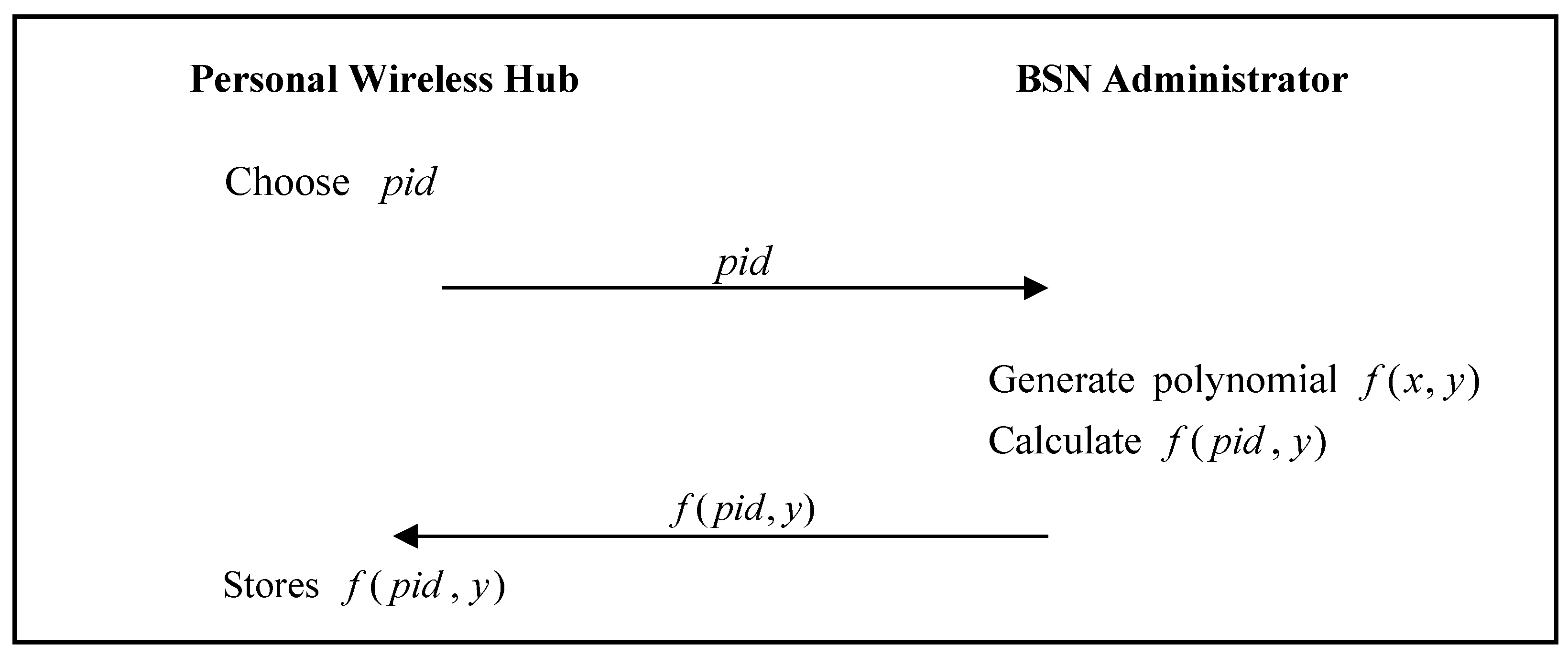
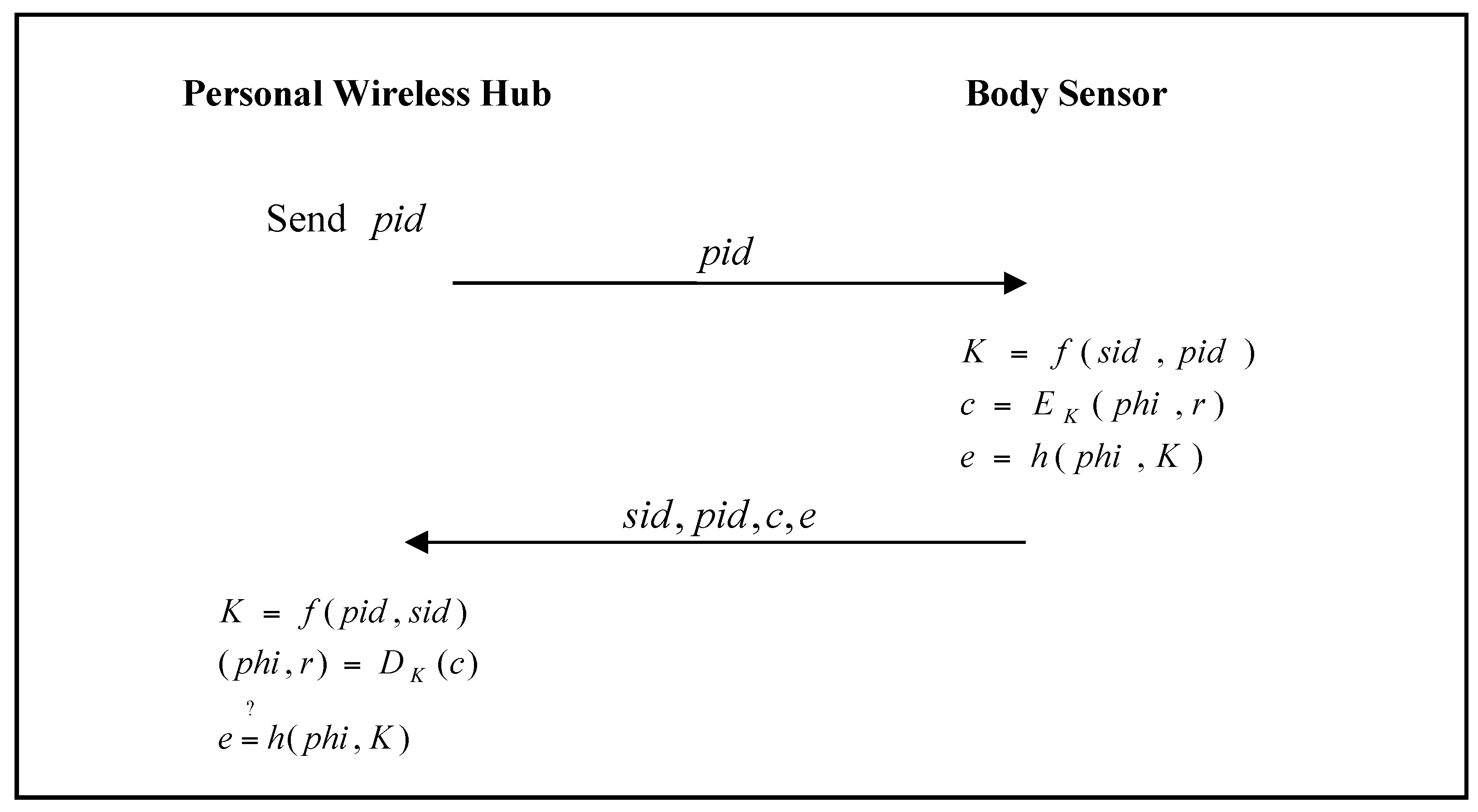
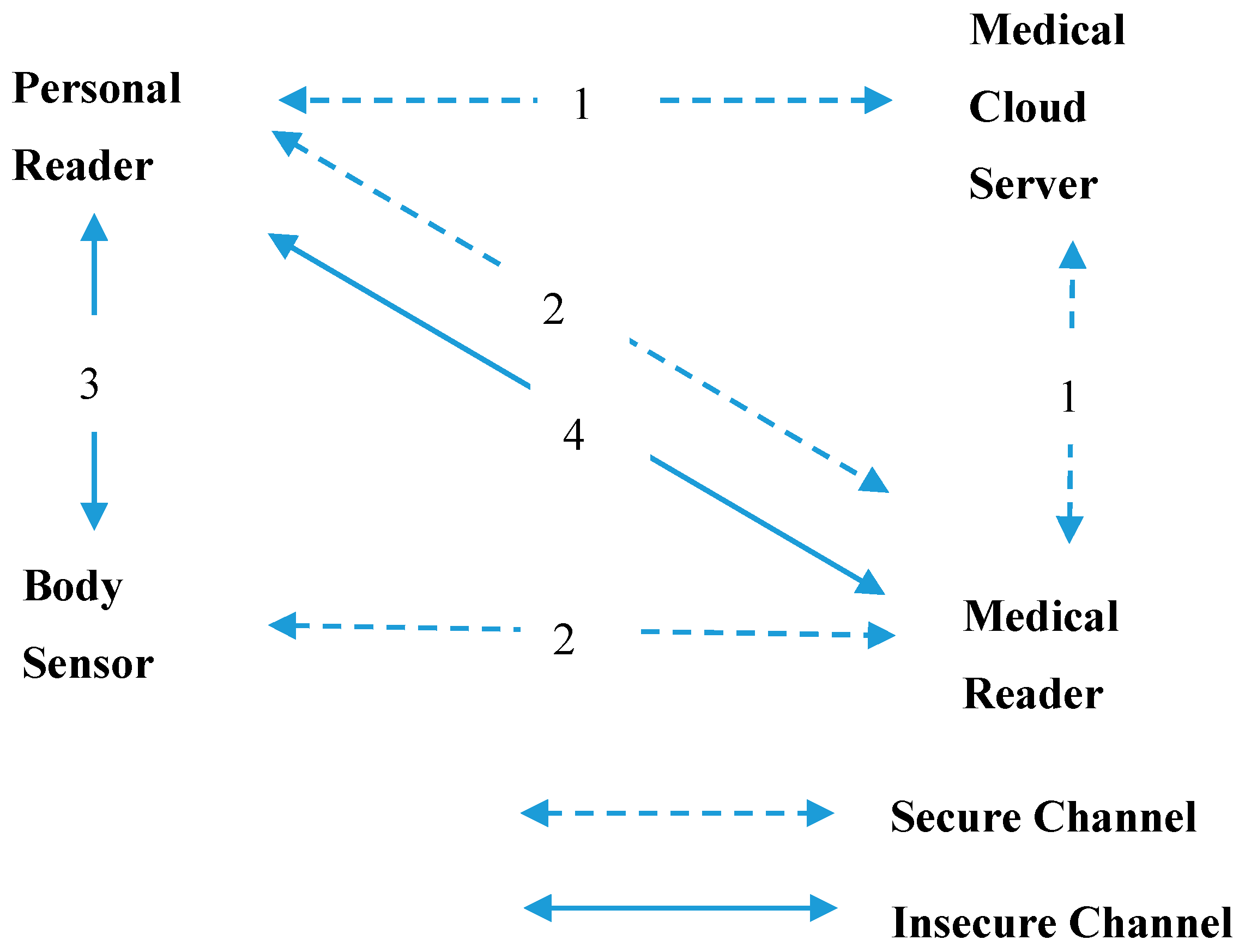
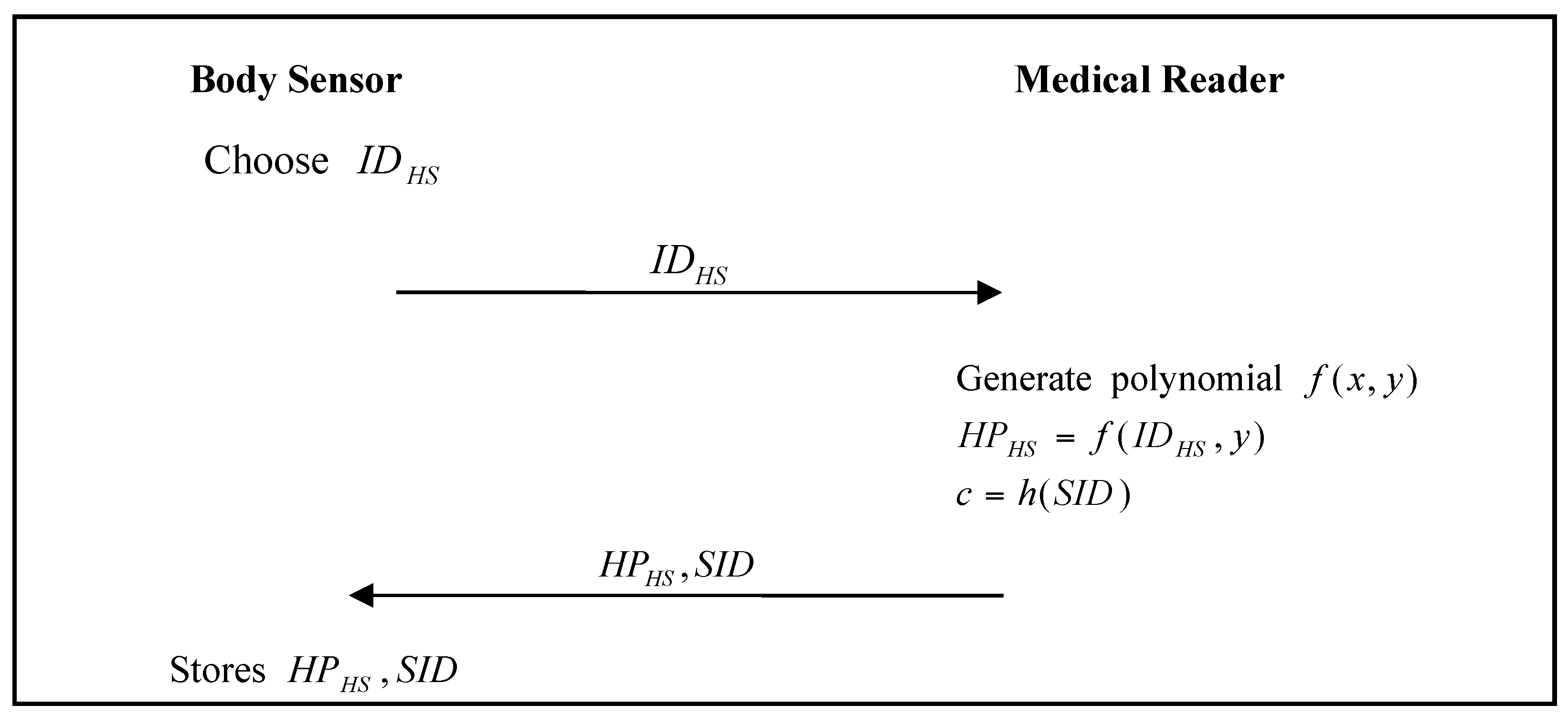
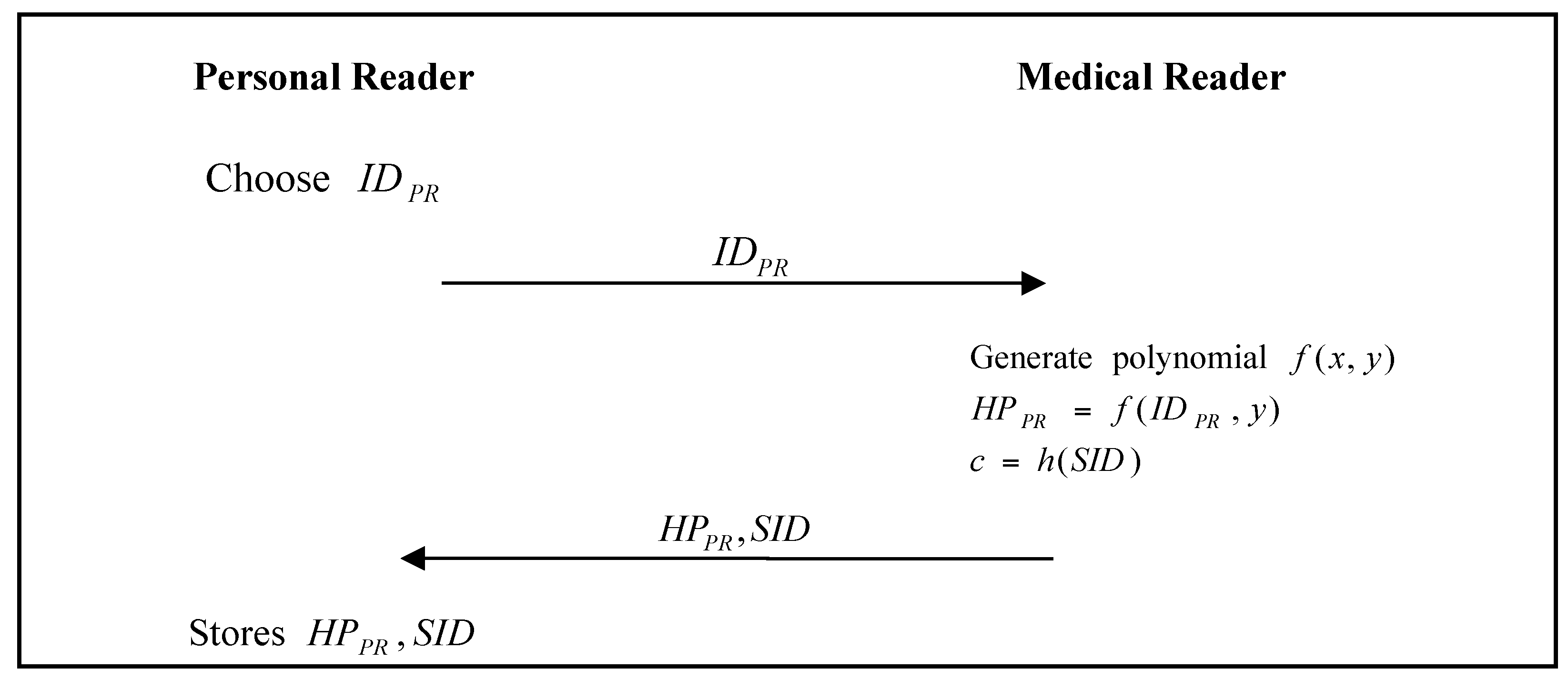


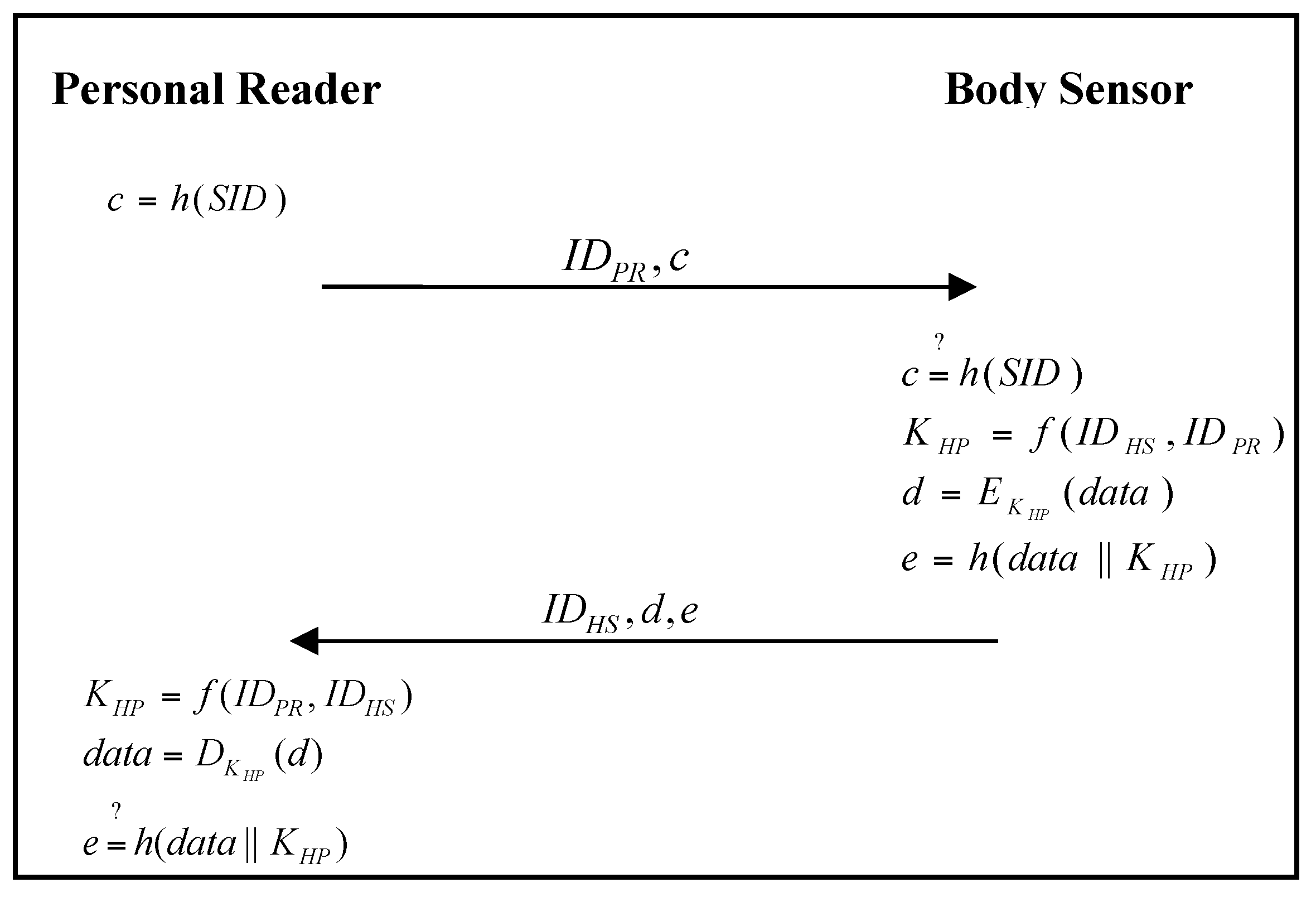
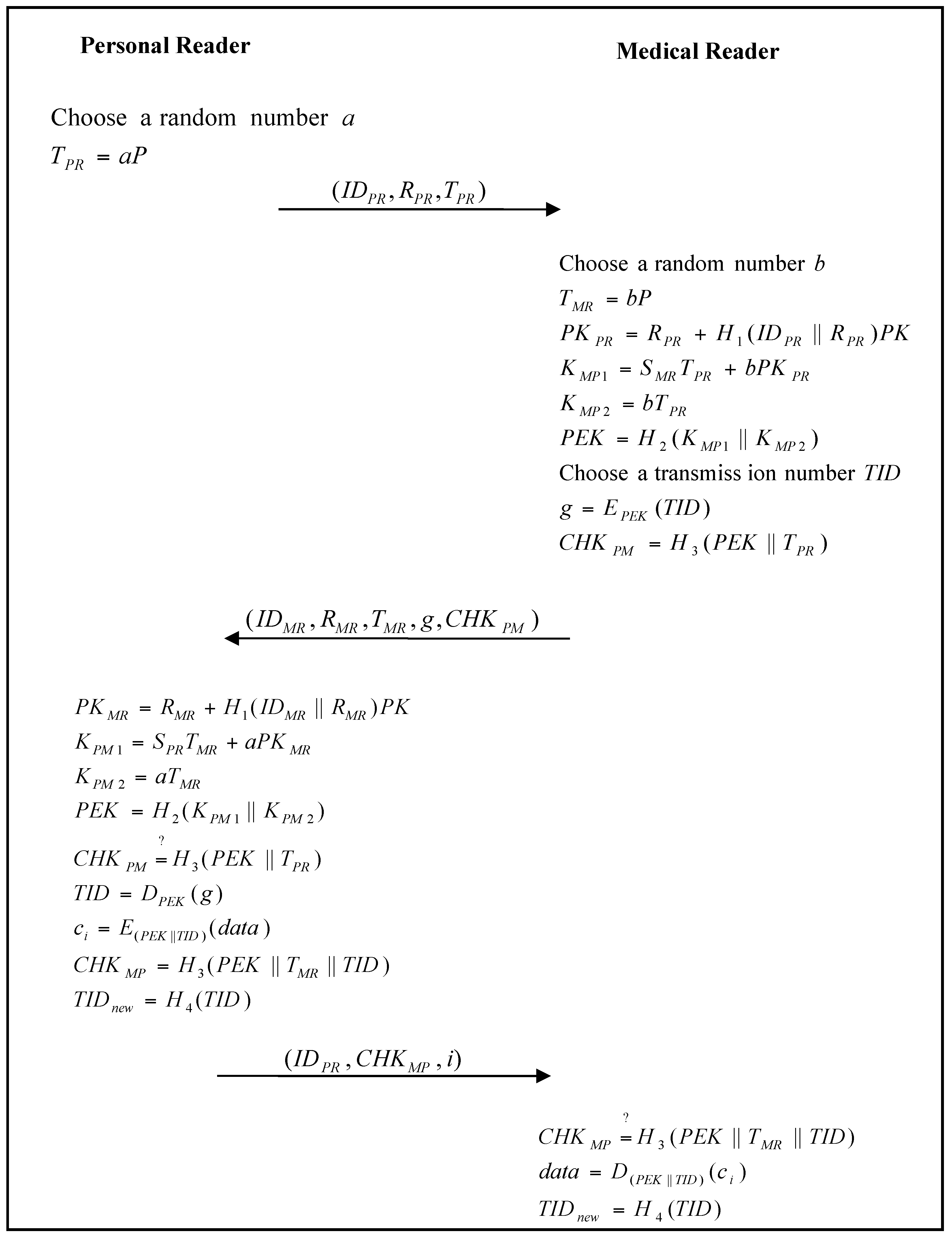
| Party | Medical Cloud Server | Medical Reader | Personal Reader | Body Sensor | |
|---|---|---|---|---|---|
| Phase | |||||
| Body Sensor Registration Phase | N/A | N/A | N/A | ||
| Personal Reader Registration Phase | N/A | ||||
| Medical Reader Registration Phase | N/A | N/A | |||
| Authentication and Communication Phase | N/A | ||||
| Item | Message Length | Round | 3.5 G (14 Mbps) | 4 G (100 Mbps) | |
|---|---|---|---|---|---|
| Phase | |||||
| Body Sensor Registration Phase | 400 bits | 2 | 0.029 ms | 0.004 ms | |
| Personal Reader Registration Phase | 880 bits | 4 | 0.063 ms | 0.009 ms | |
| Medical Reader Registration Phase | 480 bits | 2 | 0.034 ms | 0.005 ms | |
| Authentication and Communication Phase | 2448 bits | 5 | 0.175 ms | 0.024 ms | |
| Scheme | Proposed Scheme | He et al.’s Scheme | |
|---|---|---|---|
| Feature | |||
| Mutual Authentication | Yes | No | |
| Data Integrity | Yes | Yes | |
| User Untraceability | Yes | Yes | |
| Resist Replay Attack | Yes | Yes | |
| Forward and Backward Secrecy | Yes | No | |
| Comprehensive Scheme | Yes | No | |
| Scheme | Proposed Scheme | He et al.’s Scheme | |
|---|---|---|---|
| Feature | |||
| Mutual authentication between body sensor and personal reader | Yes | No | |
| Mutual authentication between personal reader and medical reader | Yes | N/A | |
© 2017 by the authors. Licensee MDPI, Basel, Switzerland. This article is an open access article distributed under the terms and conditions of the Creative Commons Attribution (CC BY) license (http://creativecommons.org/licenses/by/4.0/).
Share and Cite
Deng, Y.-Y.; Chen, C.-L.; Tsaur, W.-J.; Tang, Y.-W.; Chen, J.-H. Internet of Things (IoT) Based Design of a Secure and Lightweight Body Area Network (BAN) Healthcare System. Sensors 2017, 17, 2919. https://doi.org/10.3390/s17122919
Deng Y-Y, Chen C-L, Tsaur W-J, Tang Y-W, Chen J-H. Internet of Things (IoT) Based Design of a Secure and Lightweight Body Area Network (BAN) Healthcare System. Sensors. 2017; 17(12):2919. https://doi.org/10.3390/s17122919
Chicago/Turabian StyleDeng, Yong-Yuan, Chin-Ling Chen, Woei-Jiunn Tsaur, Yung-Wen Tang, and Jung-Hsuan Chen. 2017. "Internet of Things (IoT) Based Design of a Secure and Lightweight Body Area Network (BAN) Healthcare System" Sensors 17, no. 12: 2919. https://doi.org/10.3390/s17122919
APA StyleDeng, Y.-Y., Chen, C.-L., Tsaur, W.-J., Tang, Y.-W., & Chen, J.-H. (2017). Internet of Things (IoT) Based Design of a Secure and Lightweight Body Area Network (BAN) Healthcare System. Sensors, 17(12), 2919. https://doi.org/10.3390/s17122919






